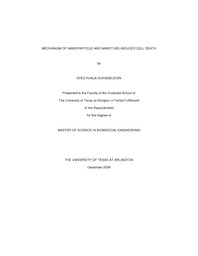
ATTENTION: The works hosted here are being migrated to a new repository that will consolidate resources, improve discoverability, and better show UTA's research impact on the global community. We will update authors as the migration progresses. Please see MavMatrix for more information.
Show simple item record
| dc.contributor.author | Sohaebuddin, Syed Khaja | en_US |
| dc.date.accessioned | 2009-09-16T18:19:59Z | |
| dc.date.available | 2009-09-16T18:19:59Z | |
| dc.date.issued | 2009-09-16T18:19:59Z | |
| dc.date.submitted | January 2008 | en_US |
| dc.identifier.other | DISS-10057 | en_US |
| dc.identifier.uri | http://hdl.handle.net/10106/1807 | |
| dc.description.abstract | Recent advances in nanotechnology have lead to synthesis of high-quality nanoparticles which exhibit unique physical and chemical properties. The novel properties of these nanoparticles are widely being applied for diagnostic and therapeutic purposes and enable new means of biosensing and targeted drug delivery. However, increasing evidence has suggested that some nanoparticles may cause detrimental effects on cells and tissues. Using titanium oxide (TiO2) nanoparticles (5-10 nm diameter), silicon oxide (SiO2) nanoparticles (30 nm diameter), and multi-walled carbon nanotubes (MWCNTs) of different diameters (<8 nm, 20-30 nm, >50 nm), 0.5-2 µm in length as test subjects, we evaluated the in vitro interaction of these nanoparticles with 3T3 fibroblasts. Our goal was to unearth the underlying mechanism of nanoparticle-induced cell death. Our results have shown that cell viability following exposure to the nanoparticles was dependent on material composition, concentration, diameter, particle exposure time. The MWCNT 20-30 nm exhibited the strongest toxicity effects to 3T3 fibroblasts, 31% reduction in cell survival at 1 µg/ml compared to 20% reduction with MWCNT <8 nm, 14% reduction with SiO2 nanoparticles at the same concentration. TiO2 nanoparticles and MWCNT >50 nm were the least toxic to 3T3 fibroblasts causing approximately 10% reduction in viable cells at a concentration of 1 µg/ml. By assessing the reactive oxygen species (ROS) generation and lysosomal membrane stability, it was observed that nanoparticles and nanotubes exposure resulted in increased generation of intracellular reactive oxygen species (ROS); this caused lysosomal membrane permeabilization (LMP) only in cells exposed to MWCNTs but not in cells exposed to TiO2 and SiO2 nanoparticles. TiO2 and SiO2 nanoparticles did cause an increase the activity of caspase-3/7, whereas cells exposed to MWCNTs did not show increased caspase-3/7 activity. These findings indicate that exposure to TiO2 and SiO2 nanoparticles caused cell death via DNA damage leading to apoptosis, whereas exposure to MWCNTs caused cell death via leakage of lysosomal hydrolases leading to necrosis. We believe that a better understanding of nanoparticle and nanotube-induced cell death will help us in the development of safe and better nano-devices. | en_US |
| dc.description.sponsorship | Tang, Liping | en_US |
| dc.language.iso | EN | en_US |
| dc.publisher | Biomedical Engineering | en_US |
| dc.title | Mechanism Of Nanoparticle And Nanotube-induced Cell Death | en_US |
| dc.type | M.S. | en_US |
| dc.contributor.committeeChair | Tang, Liping | en_US |
| dc.degree.department | Biomedical Engineering | en_US |
| dc.degree.discipline | Biomedical Engineering | en_US |
| dc.degree.grantor | University of Texas at Arlington | en_US |
| dc.degree.level | masters | en_US |
| dc.degree.name | M.S. | en_US |
| dc.identifier.externalLink | http://www.uta.edu/ra/real/editprofile.php?onlyview=1&pid=58 | |
| dc.identifier.externalLinkDescription | Link to Research Profiles | |
Files in this item
- Name:
- Sohaebuddin_uta_2502M_10057.pdf
- Size:
- 7.797Mb
- Format:
- PDF
This item appears in the following Collection(s)
Show simple item record


